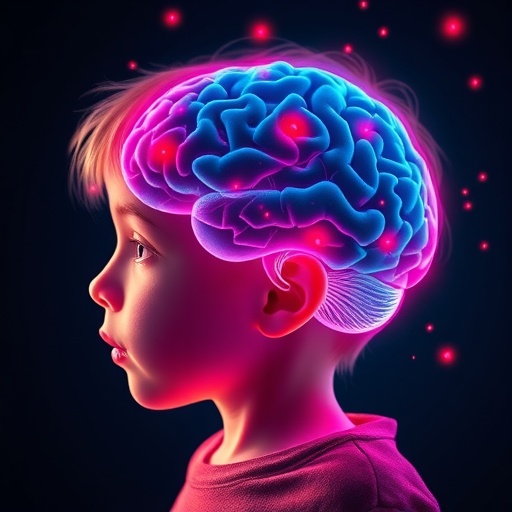In a groundbreaking study published in BMC Psychiatry, researchers have uncovered new insights into the neural underpinnings of auditory attention deficits in children diagnosed with Attention-Deficit/Hyperactivity Disorder (ADHD). This work shines a light on the complex relationship between auditory cortical functional connectivity and the impaired auditory attention frequently observed in this population. The investigation, led by Zhang et al., meticulously combines neuroimaging techniques with neuropsychological assessments to elucidate how altered brain networks contribute to the characteristic symptoms of ADHD.
Attention-Deficit/Hyperactivity Disorder is a neurodevelopmental condition characterized by symptoms such as inattention, hyperactivity, and impulsivity. Among these, difficulties in auditory attention— the ability to focus on relevant sound stimuli while filtering out distractions—are notably prevalent but have been less thoroughly explored at a neurophysiological level. This study addresses a significant gap by correlating auditory attention performance with functional connectivity metrics in auditory processing brain regions, providing a more comprehensive picture of ADHD’s neural architecture.
The researchers employed the Integrated Visual and Auditory Continuous Performance Test (IVA-CPT), a validated tool that evaluates sustained and selective auditory attention alongside visual attention. Forty-two unmedicated children with clinically diagnosed ADHD and thirty-six typically developing, healthy control peers underwent this cognitive assessment. Through this rigorous testing, it was established that children with ADHD consistently showed impaired performance, particularly in auditory attention tasks, validating the clinical observation of attentional deficits in this domain.
To probe underlying brain mechanisms, the team conducted seed-based functional connectivity analyses using neuroimaging techniques focusing on the auditory cortex and closely connected auditory-related regions. Seed-based connectivity analysis allows investigators to examine how neural signals in specific brain areas synchronize and communicate with other regions, revealing the integrity and efficiency of functional brain networks critical to sensory processing and attention.
Results from the functional connectivity analysis illuminated a complex pattern of connectivity abnormalities among children with ADHD when compared to healthy controls. Notably, there was a reduction in connectivity between the insula, right planum polare, and bilateral cerebellum. These areas contribute to auditory processing and sensorimotor integration, suggesting disrupted communication within pathways essential for modulating auditory attention and sensory integration in ADHD.
Concurrently, diminished connectivity was observed between the left Heschl’s gyrus, a primary auditory processing area, and the right insula, as well as between the planum temporale and the right insula. The insula’s role as a hub for multisensory integration and salience detection implicates its weakened interrelations in the attenuated ability to prioritize auditory stimuli, critical for selective attention in noisy environments—a common challenge for children with ADHD.
Contrasting with these reductions, certain brain regions exhibited heightened connectivity in the ADHD group, including increased functional coupling between the right Heschl’s gyrus and the superior frontal gyrus. Additionally, connectivity among the bilateral middle frontal gyrus, right supramarginal gyrus, and right planum temporale was also elevated. Such hyperconnectivity might represent compensatory mechanisms or reflect neural circuit dysregulation leading to inefficient attentional control, which can manifest behaviorally as distractibility or over-responsiveness to auditory stimuli.
The study importantly correlates these functional connectivity changes with auditory attention performance as measured by the IVA-CPT, grounding the observed neural abnormalities in behavioral deficits. This convergence of neuroimaging and cognitive data strengthens the inference that disrupted auditory networks are integral to the pathophysiology of ADHD’s auditory attention impairments.
Beyond elucidating neurobiological pathways, the findings open novel avenues for targeted therapeutic interventions. The implicated auditory cortical regions and their connectivity profiles could be leveraged to develop neuromodulatory treatments such as neurofeedback, transcranial magnetic stimulation, or pharmacological strategies tailored to ameliorate auditory attentional deficits. Such precision approaches could enrich the currently limited repertoire of ADHD interventions.
The researchers emphasize that these connectivity alterations likely represent part of a broader network-level dysfunction in ADHD, encompassing both hypo- and hyperfunctional circuits that shape sensory processing and attentional control. Understanding these neural dynamics offers promising prospects not only for ADHD but extends to other neuropsychiatric disorders featuring attentional impairments.
This study, by rigorously integrating behavioral measures with functional neuroimaging data, builds a compelling neurophysiological model for auditory attention deficits in children with ADHD. It underscores the necessity of considering auditory cortical network integrity when diagnosing and treating auditory cognitive dysfunctions in this demographic.
As early auditory attention plays a foundational role in language acquisition, learning, and social communication, these insights have far-reaching implications. Addressing these neural deficits could substantially enhance educational outcomes and quality of life for children affected by ADHD.
Looking forward, longitudinal and interventional studies are needed to determine whether modifying these functional connectivity patterns can translate into sustained improvements in auditory attention and overall ADHD symptomatology. Meanwhile, this study sets a benchmark for future research exploring sensory-specific deficits within broader attentional disorders.
By unveiling the nuanced alterations in auditory cortex connectivity and their behavioral correlates, Zhang et al.’s research charts a critical step toward unraveling the complex neurophysiology of ADHD, positioning auditory attention deficits as a tangible neural target for therapeutic innovation.
Subject of Research: Auditory attention deficits and functional connectivity in the auditory cortex of children with Attention-Deficit/Hyperactivity Disorder (ADHD).
Article Title: Altered auditory attention and functional connectivity in the auditory cortex of children with Attention-Deficit/Hyperactivity Disorder.
Article References: Zhang, M., Yu, J., Li, H. et al. Altered auditory attention and functional connectivity in the auditory cortex of children with Attention-Deficit/Hyperactivity Disorder. BMC Psychiatry 25, 1033 (2025). https://doi.org/10.1186/s12888-025-07516-6
Image Credits: AI Generated




